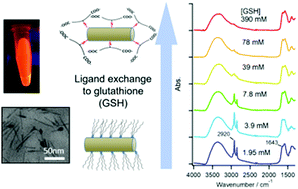FTIR study of the surface-ligand exchange reaction with glutathione on biocompatible rod-shaped CdSe/CdS semiconductor nanocrystals†
Abstract
Semiconductor nanocrystals (SNCs) are an essential optical tool in life sciences. Application of SNCs to living systems requires that their surfaces be covered with biocompatible molecules. The surface capping of SNCs by glutathione (GSH) is an effective means to prepare biocompatible SNCs and involves replacement of the initial surface ligands with GSH. However, molecular insight into such ligand-exchange reactions remains elusive. Molecular insight into this process is important, because surface ligands significantly impact physical properties such as the stability and quantum yield of SNCs. In this study, we investigate the ligand-exchange reaction of GSH on rod-shaped CdSe/CdS SNCs by Fourier-transform infrared (FTIR) absorption spectroscopy. The structure and interactions of GSH on SNC surfaces are clarified. Quantitative determination of the GSH molar fraction on SNC surfaces reveals that ∼3% of the initial trioctylphosphine oxide (TOPO) ligand is retained. Concentration-dependent experiments show that the surface molar fraction of GSH impacts the physical properties, solubilization yields, and quantum yields of SNCs in a linear manner.



 Please wait while we load your content...
Please wait while we load your content...